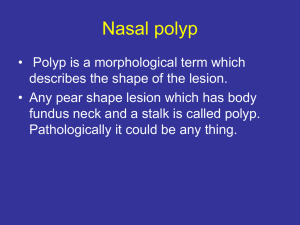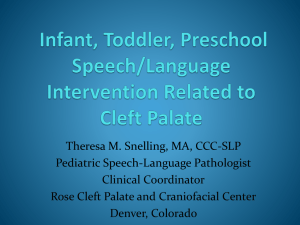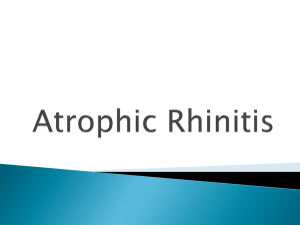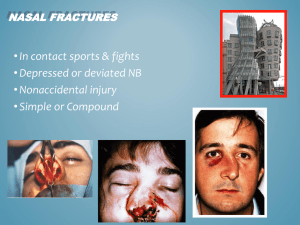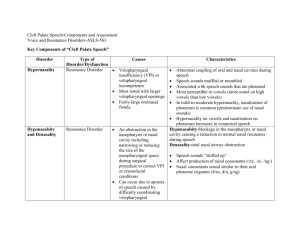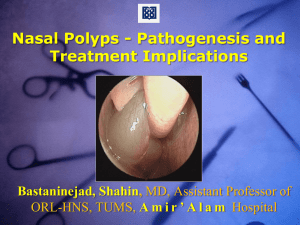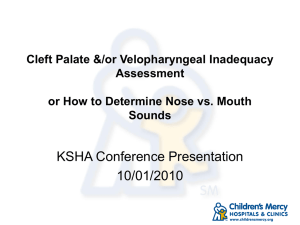diagnosis and evaluation of velopharyngeal insufficiency
advertisement
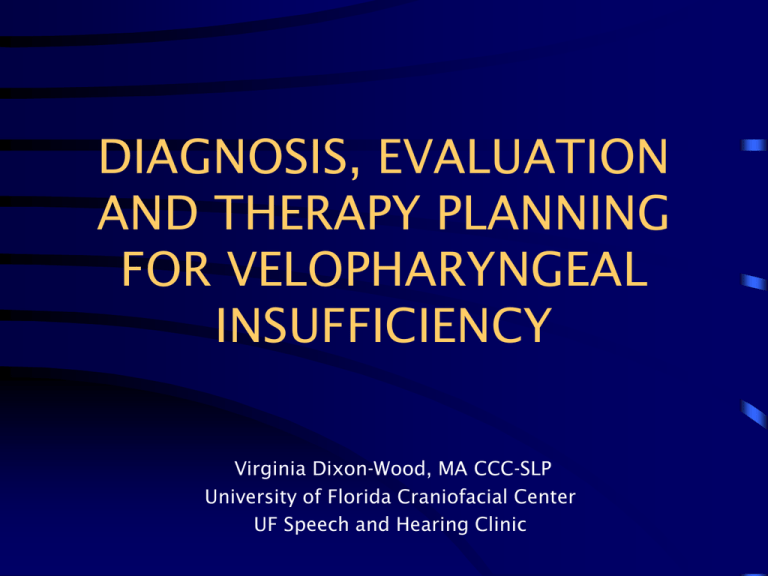
DIAGNOSIS, EVALUATION AND THERAPY PLANNING FOR VELOPHARYNGEAL INSUFFICIENCY Virginia Dixon-Wood, MA CCC-SLP University of Florida Craniofacial Center UF Speech and Hearing Clinic Common Misconceptions • Any speech pathologist can treat children with VPI • Hypernasality is the major speech problem • Speech therapy won’t help until surgery is done • VPI is a voice disorder • Refer to ENT or neurologist Insufficiency vs. Incompetency • Structurally based -cleft palate, submucous cleft • Motor based - stroke, cerebral palsy, low tone, TBI • Mix- VCFS (22q-) PRE-NATAL COUNSELING • Cleft lip only • Potential for cleft palate based on severity (width) of cleft lip • Up to 50% of families now know prenatally • In the long run, families do much better Birth to 6 months • Feeding instruction and counseling • Speech and Language development • Hearing related issues SPEECH COUNSELING • Many children may never need speech therapy • Palate closure at 8-12 mo. • Six month speech evaluations • Parent counseling 6 months- 1 year • REEL Scale 2 Receptive-Expressive Emergent Language Scale – Bzoch Birth to 3 years 6 months – 1 year • Discuss surgery (9-12 months) • Parents expectations • Surgery counseling 12 mo. - 2 years • Begin phonological inventory range of sounds oral/nasal contrast • REEL Scale – refer for EI • Parent counseling Stages of Speech Development • Vocalizations - birth • Babbling - C+V repetition, 3 mo. • Jargon - mixed C+V, 8 mo. • First “true word”- 10-12 mo. • Two word combinations - 18 mo. Early Speech Development • Non- cleft • m, n • d, b, p, g • y, w • Cleft • m, n • g • y, h, w Speech Characteristics of the Young Child with Possible VPI • Delayed expressive language development • Very limited phonologic inventory m,n,h,y and some vowels • Use of speech template • Consistent nasal substitutions Early Speech Development Sound differentiation Nasal vs. Oral bye-bye vs. mye mye bye-bye vs. i i bye-bye vs. ? ? Preschool • Can assess palatal function • Informally – predominately nasals and vowels vs. combination of nasal and pressure sounds • Stimuli – baby, puppy, bye bye • Formally – Measures of nasal emission and articulation testing Speech Characteristics of VPI • Glottal compensations • Nasal substitutions • Inappropriate nasal air emission • Weak pressure consonants • Hypernasality Preschool Evaluation of VPI: Sound Production Audible nasal emission Glottal Compensations Perceptual testing • Nasal emission • Articulation • Resonance • Intelligibility Communicative Disorders Test Kenneth R.Bzoch • Designed for specific speech characteristics of cleft palate clients • Articulation • Resonance • Nasal emission • Voice - hoarseness, aspirate voice quality Audible nasal air emission • Inappropriate air leakage through the nose during the production of consonants • Tested on high pressure sounds plosives or continuants /p,b,s/ Nasal Air Emission • Tests inappropriate nasal air escape during the production of high pressure consonants /p,b/ • Use visual or auditory feedback - ppaddle, mirror, listening tube • Base 10 index • Document change Resonance • Relationship between size of oral and nasal resonating cavities • Normal resonance – balanced • VPI creates a increased nasal resonating cavity • Cold/allergies create a decreased nasal resonating cavity Resonance • Perceived during vowel production • Cul-de-sac testing • Listener perception Hypernasality • Abnormal amount of nasal resonance • Negative impact on listener • Perceived during vowel production • Tested on vowels with oral consonants • beet, bit, bait, bought, boat Hyponasality • Too little nasal resonance • Not perceived as negatively by listener • Common cold, allergies, sinusitis, enlarged tonsils and adenoids, pharyngeal flap • Cul-de-sac testing • Nasometry Hypernasality • Vowels with /b/ • If resonance is normal (oral)- there should be no difference between the 2 productions • Base 10 index • Document change Hyponasality • Vowels with /m/ • If normal resonance, there should be a difference (shift) between words • Base 10 • Document change Significance • Indexes of 3/10 or greater • Do indexes match what you are hearing in conversational speech? • Impact on the child and/or family? Voice • Vowel prolongation- timed • Aspirate -may be compensation to conceal hypernasality • Hoarseness - may be caused by glottal compensations Error Pattern Diagnostic Articulation Test • Developed for patients with cleft lip/palate • Based on manner of production • Classifies many different errors - correct, NE, distortion, simple/glottal substitution, omission • Error and articulation scores • Documents change Speech Sample • Spontaneous single words • Conversation • Estimate a % • Does it validate your other test results? Palatal Fistulae • Opening along the suture line • Assess size (mm) • Document location • Can be responsible for abnormal articulation patterns • Nasal emission Fistula • Important part of oral exam • Anterior fistulae - impact on articulation • Nasal emission - may be inconsistent or phoneme specific • Resonance - may be normal Fistula • Recommendations based on speech results: surgical closure obturate do nothing NOW WHAT ? Creating the Treatment Plan • Age • Articulation vs. resonance • Severity of articulation disorder • What is interfering the most with intelligibility • Child and family reaction • What can you treat? SPEECH THERAPY • WHAT? • WHY? • WHEN? • HOW? Treatment Plan You have to understand the problem before you can create a treatment plan Not understanding the problem can create additional articulatory compensations Can waste valuable time and money Treatment Plan • Nasalized – diagnostic therapy to see if child can impound oral pressure (short term) • Glottal compensations – help the child learn to create oral breath pressure What NOT to do • Muscle Training: (Cole, 1979) • Indirect • Semidirect • Direct What NOT to do • Yules, 1968 • Subjects were able to reduce nasal emission on short tests but that establishment of performance in automatic speech remained to be demonstrated What NOT to do • McWilliams-no evidence that muscle training had any impact on improving speech or reducing nasal emission Misarticulations • Judy Trost-Cardamone, 1997 • Obligatory errors - physical management hypernasality, nasal emission, weak pressure consonants • Passive/Learned Errors compensatory errors, phoneme specific Treatment Planning • Child 1 • Increase movement of articulators • Vowels • Increase intelligibility /m,n,y,h,w,l/ • Frication • Pressure sounds Treatment Planning • Child 2 • Develop oral air flow • Vowels • Increase intelligibility /m,n,y,h,w,l/ • Frication • Pressure phonemes Speech Therapy • Delayed speech development in young children but without glottal compensations • Nasal emission distortion/unintelligible speech • Poor articulatory movement Speech Therapy • Goal: Improve articulation/intelligibility • Hypernasality and nasal emission are not priorities • Improve movement of articulators • Accurate vowel production • Low pressure consonants Speech Therapy • Delayed speech development with glottal compensation Improve intelligibility • Establish oral airflow - this is imperative • Can create “popping” or “clicking” for pressure sounds Speech Therapy • Child with glottal compensations: • Improve articulatory movements • Accurate vowels • Low pressure consonants - oral airflow • Frication • Plosives Speech Therapy • Glottal compensations • Sonorants • Unvoiced • Final position Speech Therapy • Glottal compensations- Begin with ANTERIOR sounds Speech Therapy • Multisensory • Not successful at duplicating what they have heard • Visual • Tactile • Kinesthetic Speech Therapy • Glottal Articulation • TEACHING PLACEMENT IS NOT ENOUGH • CAN CREATE CO-ARTICULATIONS Palatal Fistula vs. VPI • Obturate fistula • Speech therapy - 3-6 months • Objective testing VIDEOFLUOROSCOPY • Poor candidates: • compensatory articulation • poor articulation skills • significant palatal fistula • very young or uncooperative child Impact of Articulation on Velar Function • Glottal articulation can “shut down” palatal movement • Often there is little movement of the articulators as well • Palatal fistulae can also impact velar function


